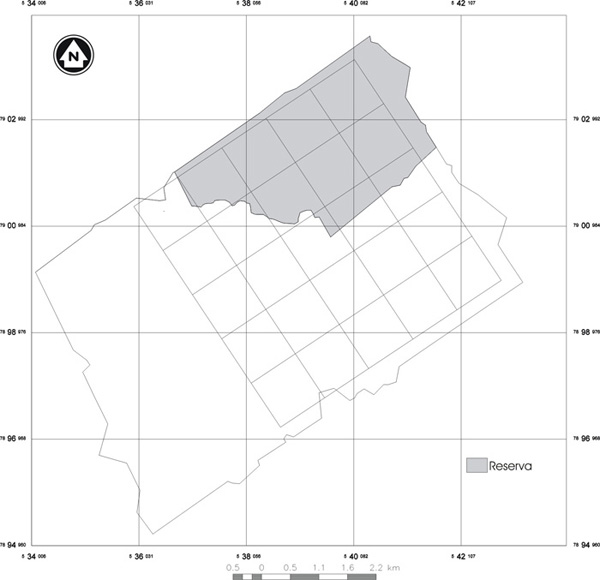Languages
Nhumirim (Southern Pantanal)
The Pantanal Sul Permanent Grid is installed at the Nhumirim Experimental Farm, a farm owned by Embrapa Pantanal. It is a standard RAPELD grid (25 km2). Data of this type are the most complete and most useful for long-term monitoring and geographical comparisons. These are probably suitable for most analyzes. We suggest that grid monitoring studies use the methods described in data metrics from previous PPBio studies, or include a calibration phase within the project to ensure that the data can be compared.
Map of the Pantanal Sul Grid
As partners in the activities related to the permanent grid are Embrapa Forests, Federal University of Mato Grosso do Sul (Campus of Campo Grande and Pantanal), Federal University of Mato Grosso, UNB (Brasilia University) and Cena-USP.
In these transects surveys and surveys related to mammals, birds, reptiles and amphibians, vegetation, soil microbiota, carbon cycle, characterization of hydroclimatic behavior and invertebrates are being carried out.
At the Fazenda Nhumirim experimental station, other research activities are developed. The grid includes a protected area of more than 800 ha, and areas used for cattle breeding, which allows comparative studies. Research related to livestock production is routinely developed in the area of the grid, but not using the structure and transects. There are no deforestation activities in the entire grid area, nor replacement of native vegetation with cultivated exotic pastures, except for a small stretch where this type of management already existed when the grid was implanted. Other wildlife research projects are also developed, involving catches of various species of mammals for radio-telemetry studies.

Map of the grid within the Fazenda Experimental Nhumirim reserve
Metadata
Guidelines to facilitate the search in the repository: in the search page of the link above, type the keyword: Pantanal Sul
Funding
The implementation of the permanent grid and the development of research have been funded by various sources through different research projects and thus there is no single related project. Initially, the resources were made available by MCT through the project "Use of multi-scale models of species-habitat relationship in the Pantanal to define indicators of ecological sustainability" coordinated by Walfrido Tomas (Embrapa Pantanal), and belonging to the Livestock Sustainability Network In the Pantanal. The Network is managed by the Pantanal Research Center - CPP, in agreement with the MCT. The project also receives a substantial financial contribution from Embrapa through the project "Multi-scale analysis of biodiversity standards to define criteria for sustainable management in farms in the Pantanal", coordinated by Suzana Salis (Embrapa Pantanal), in which the permanent grid is the Approach. In addition, some activities are also supported by CNPq through the PELD Sitio 2 - Pantanal Sul project entitled "Long-term ecological responses to multi-annual floods in Pantanal Mato Grosso" coordinated by Guilherme Mourão. Specific project activities have also been funded by FUNDECT / CNPq (project Study of Occurrence and diversity of diazotrophic bacteria associated with legumes and forage grasses predominant in the Nhecolândia Pantanal), coordinated by Marivaine Brasil (UFMS-Pantanal), and the project "Bioprospection Of filamentous fungi in the Pantanal Sul Mato Grosso ", coordinated by Fabiana Fonseca Zanoelo (UFMS).
Contacts
Suzana Maria de Salis
Embrapa Pantanal
Rua 21 de Setembro 1880
CEP 79320-900
Corumbá, MS
Phone (67) 3233-2430
Walfrido Moraes Tomas
Embrapa Pantanal
Zilca Campos
Embrapa Pantanal
Rua 21 de Setembro 1880
CEP 79320-900
Corumbá, MS

